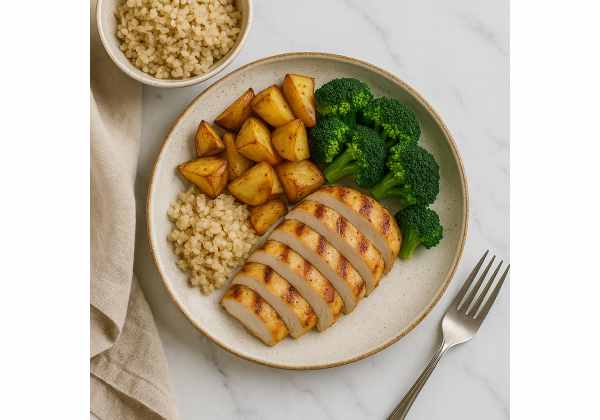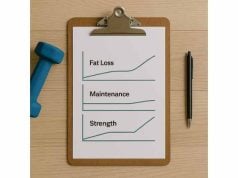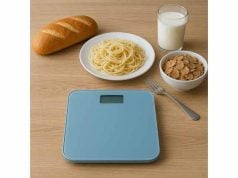
Reaching your goal weight should feel like a finish line. For most people, it is the start of a new phase: learning how to eat enough to live and train well without watching the scale climb. The solution is not guesswork or fear of carbs; it is a simple, repeatable method to discover your true maintenance calories and hold them. This guide shows you how to set an initial target, run a two-week validation, and install the habits that prevent rebound. If your weight has been jumpy or stalls are confusing, keep our concise plateau troubleshooting guide nearby as you work through the steps.
Table of Contents
- What maintenance calories are
- Quick method to estimate
- Two-week maintenance test
- Macros and meal structure
- Common mistakes and fixes
- Special cases and adjustments
- Decide your next phase
- Frequently Asked Questions
What maintenance calories are
Maintenance calories are the average number of calories that keep your weight stable over several weeks while your habits—sleep, steps, training, and food choices—are consistent. Maintenance is not a single exact number; it is a band with day-to-day highs and lows that average out.
Why maintenance matters after a diet
- It protects your progress. A controlled maintenance phase consolidates fat loss, normalizes hunger, and steadies hormones and training performance.
- It builds the lifestyle you plan to keep. The goal is not to “hold on” nervously; it is to live at maintenance with confidence.
- It sets your next choice: recomposition, strength focus, or a future, shorter cut.
How maintenance changes across a diet
When you lose weight, your body mass is lower and you often move slightly less, so your energy needs come down. Your old maintenance is not your new maintenance. The difference is usually modest—often a few hundred calories—not a thousand-calorie cliff.
Signs you are near maintenance
- Your 7-day average weight stays within about ±0.5% for two to three weeks.
- You feel predictably hungry before meals, not ravenous all day.
- Training quality improves or holds steady; sleep feels normal.
- Waist measurement stays within a small range (±0.5–1.0 cm).
Maintenance is a range, not a point
Think in weekly averages. You might eat 1,900 calories on rest days and 2,200 on lifting days. If your weekly average lands around 2,050 and your weight and waist are steady, that is maintenance—for this season, with this routine.
If you want a quick refresher on energy balance and the pillars that support any phase, skim our concise weight loss basics before you begin.
Key takeaway: Maintenance is a band that keeps your weight and waist steady while you train and live normally. It adapts with your body, steps, and schedule—so you will measure it, not guess.
Quick method to estimate
Start with a practical estimate, then verify it against real-world data. You do not need a complex calculator to get close enough to test.
Step 1 — Choose a reasonable starting point
Use one of these simple heuristics:
- Body-weight method:
- If you are moderately active (7–10k steps/day, 2–4 lifts/week): body weight (lb) × 14–16.
- If you are more sedentary (≤6k steps/day, minimal training): body weight (lb) × 12–13.
- If you are very active (12k+ steps/day, 4–6 hard sessions/week): body weight (lb) × 16–18.
- Reverse from your diet:
- If you lost ~0.5 kg (1 lb) per week eating X calories, your maintenance ≈ X + 500 (because 1 lb fat ≈ 3,500 calories/week ≈ 500/day).
- If you lost ~0.25 kg (0.5 lb) per week at X, maintenance ≈ X + 250.
Pick the lower end if you are smaller, older, or move less; pick the upper end if you are larger, younger, or highly active.
Step 2 — Set protein and split the rest
- Protein: 0.7–1.0 g per lb of goal body weight. This stabilizes appetite and protects lean mass.
- Carbs and fats: allocate the remaining calories to suit preference and training. Carbs generally support volume and recovery; fats support satiety and hormones. Do not drop fat below ~0.3 g per lb of body weight for long stretches.
Step 3 — Build a one-week menu scaffold
- Choose 3–5 repeatable meals you enjoy that hit your protein target.
- Log cooking oils, sauces, and drinks. Hidden calories often live there.
- Keep steps and bedtimes consistent for fair testing.
Step 4 — Weigh right to read the trend
- Weigh daily under the same conditions (after bathroom, before food).
- Judge the 7-day average, not single mornings. Our simple weigh-in protocol makes this painless.
What results mean after seven days
- Average up >0.5% and waist up → you overshot; trim 100–150 calories/day.
- Average flat, waist steady → you are close; hold and run week two to confirm.
- Average down with normal hunger → you are still in a small deficit; add 100 calories/day and retest.
Key takeaway: Use a simple formula and a one-week scaffold to get close. Then let averages, not feelings, tell you whether to adjust.
Two-week maintenance test
The two-week test confirms your true maintenance in your real life—with your work schedule, training, and weekends included. It prevents “calculator maintenance” from turning into regain.
Week 1 — Stabilize inputs
- Food: keep meals similar each day; measure at least one component per meal (protein or starch) by grams.
- Movement: set a step floor you can hit on busy days (e.g., 7–9k).
- Training: keep exercise selection the same; no heroic volume spikes.
- Sodium: cook most meals at home; avoid back-to-back restaurant nights.
- Alcohol: cap at 0–4 drinks/week, avoid late-night rounds.
Log daily weight, 7-day average, weekly waist, and training notes (sleep, soreness, appetite).
Week 2 — Stress test gently
Life is not perfect. Add one or two normal challenges:
- A dinner out with friends.
- A long workday.
- A weekend training block.
Keep the rest steady. The aim is not to win perfection; it is to see whether your plan holds when reality shows up.
Decision rules at Day 14
- Average weight change within ±0.5% and waist within ±0.5–1.0 cm → This is maintenance. Keep your current weekly average calories and proceed to the next section.
- Average up >0.5% and waist up → lower by 100–150 calories/day or add 1,500–2,000 steps/day and hold for another week.
- Average down (you keep losing) → raise by 100 calories/day and retest week-by-week until the trend stabilizes.
Guardrails during the test
- Do not yo-yo: avoid big day-to-day swings to “fix” a single weigh-in.
- Keep training consistent: new soreness holds water and clouds readings.
- Mind the carb ramp: if you recently increased carbs, expect normal water shifts for 7–14 days. For background on those swings (and how to read them), review the gist in carb reintroduction.
After the test: set your weekly operating plan
- Keep two weekday menus and one flexible weekend pattern you can repeat.
- Note your weekly average calories in your tracker. That number is more useful than daily highs or lows.
- Schedule a weekly five-minute review: weight average, waist, how training felt, and one small improvement for the next week.
For an example of how to steer the first maintenance month, see the practical guardrails in our playbook for the first 8 weeks at maintenance.
Key takeaway: Two steady weeks—one controlled, one lightly challenged—are enough to prove your maintenance and reveal the smallest change needed.
Macros and meal structure
Finding maintenance calories is step one. Holding maintenance without drift requires smart macro targets and a meal rhythm you enjoy.
Protein: the anchor across phases
- Aim for 0.7–1.0 g per lb of goal body weight.
- Distribute across 3–4 meals with 25–40 g protein each to control hunger and support training.
- Use convenient tools: Greek yogurt, cottage cheese, eggs, lean meats, tofu/tempeh, protein shakes.
Carbs: fuel training and daily movement
- With maintenance established, most active people feel best with 40–50% of calories from carbs, scaled to training volume.
- Place 40–60% of daily carbs around workouts (pre + post) to improve performance and recovery.
- Choose a mix of quick-digesting sources (fruit, white rice, low-fat dairy) and slower sources (oats, potatoes, whole grains).
Fats: satiety and flexibility
- Keep fats at or above ~0.3 g per lb of body weight most days.
- Use olive oil, avocado, nuts, whole eggs, and fatty fish.
- Let fats rise slightly on rest days when your carbs dip.
A simple plate you can repeat
- Half plate: vegetables or fruit.
- Quarter plate: lean protein.
- Quarter plate: starch or grain.
- Thumb or two: fats or sauces.
This structure makes eating out easier: if portions are large, leave a few bites of the starch and keep protein as the priority.
Meal timing options
- Three meals + snack: reliable for appetite control and busy schedules.
- Four smaller meals: good for smaller appetites and training later in the day.
- Pre/post-workout focus: small protein + carb snack before lifting; balanced meal after.
For a deeper walkthrough of setting maintenance macros that keep you satisfied without drift, scan our focused guide to maintenance macros and adapt the examples to your pantry.
Key takeaway: Keep protein high, put carbs where you work the hardest, and use a repeatable plate method. A few meals you love—on rotation—beat perfect plans you will not follow.
Common mistakes and fixes
Regain is rarely caused by one big decision. It comes from small patterns repeated weekly. Spot them now and install a fix the same day.
Mistake 1 — Weekend drift erases the week
You eat on-plan Monday–Thursday, then add 1,000–2,000 unplanned calories Friday–Sunday with drinks and restaurant meals.
Fixes that work:
- Set two “on-plan” meals on the weekend and one indulgent meal.
- Choose drinks or dessert, not both, and cap drinks at 0–4/week.
- Walk 10–20 minutes after larger meals.
If weekends are your weak spot, borrow a few practical tactics from our weekend fixes to keep your weekly average intact.
Mistake 2 — Under-eating protein
Maintenance feels hungrier than cutting because your brakes (diet fatigue) are off but your habits are new.
Fixes that work:
- Commit to 25–40 g of protein per meal.
- Build protein-first snacks (Greek yogurt, cottage cheese, jerky, edamame).
Mistake 3 — Letting steps collapse
Less structure after a diet often means less movement, shrinking your maintenance band.
Fixes that work:
- Pick a step floor (7–10k) that survives busy days.
- Anchor 5–10 minute walks after meals or calls.
Mistake 4 — Calorie amnesia
“Eyeballing” oils, dressings, and bites quickly stacks calories.
Fixes that work:
- Measure oils and sauces for two weeks.
- Keep a two-minute log immediately after meals.
- Order sauces on the side when you eat out.
Mistake 5 — New training volume spike
Jumping into a high-volume program adds soreness, water, and hunger right when you are testing maintenance.
Fixes that work:
- Keep exercise selection steady for the two-week test.
- Add reps before load; deload every 4–8 weeks.
Mistake 6 — Fear-based under-eating
You undershoot calories after a diet, then rebound with late-night snacking.
Fixes that work:
- Respect your maintenance band: it is usually a few hundred calories wide.
- Eat predictable meals during the workweek; get creative on weekends within guardrails.
Key takeaway: Maintenance is not fragile. A few anchors—protein, steps, meal structure, alcohol limits—turn it into a routine that survives real life.
Special cases and adjustments
Some contexts call for tweaks to your maintenance plan. Adjust your expectations and methods rather than forcing a one-size-fits-all approach.
Medications and medical factors
Certain antidepressants, antipsychotics, mood stabilizers, steroids, and other drugs can influence appetite, water handling, and energy use.
- What to do: do not change prescriptions without your clinician. Track carefully for two weeks, emphasize protein and sleep, and discuss options with your provider. Our overview of medication-related stalls can help frame the conversation.
Menstrual cycle and perimenopause
Late luteal phase water shifts can mask maintenance (or ups) for 5–7 days. Compare the same cycle phase month to month. In perimenopause, prioritize sleep and strength quality, use smaller deficits if you plan future cuts, and give yourself longer time horizons.
High stress and sleep debt
Short sleep raises hunger, lowers restraint, and reduces NEAT. Protect a regular bedtime, keep caffeine earlier in the day, and add easy movement. If you are coming off a hard push, start with recovery—see how to repair your recovery—then test maintenance.
Endurance vs. strength priorities
- Endurance block: your burn is higher on long days and lower on rest days; use bigger day-to-day swings that keep the weekly average in range.
- Strength block: keep daily calories steadier; place more carbs around lifting; use deloads to control soreness-related water.
Travel and holidays
Choose maintenance on purpose, not by accident. Pack protein snacks, walk after meals, and keep bedtime boundaries. Return to your weekday scaffold the first day back.
Key takeaway: Context—medications, hormones, stress, sport—shifts your maintenance band. Plan for it and you will stay in control.
Decide your next phase
With maintenance confirmed, choose a clear, time-boxed goal for the next 6–12 weeks. Clarity prevents drift.
Option A — Consolidate at maintenance
Best for: recent dieters, anyone with unstable sleep or a busy season.
- Keep weekly average calories at your proven maintenance.
- Push performance PRs and technique in the gym.
- Practice restaurant meals and social flexibility while the scale holds steady.
Option B — Recomposition at maintenance
Best for: lifters who want shape and performance more than lower scale numbers.
- Keep calories near maintenance.
- Lift 3–4 days/week and prioritize progressive overload.
- Track waist, photos, and strength as primary metrics; the scale may stay flat.
Option C — Short, targeted cut
Best for: those with energy, sleep, and habits in place.
- Drop 10–15% below maintenance for 6–8 weeks.
- Keep protein high and volume moderate; deload once if needed.
- End with 4–6 weeks back at maintenance to reconsolidate.
Option D — Strength focus
Best for: those who want momentum in the gym.
- Stay at maintenance to +5% if you are comfortable with small, controlled gains.
- Keep cardio at a level that supports recovery, not steals from lifting.
How to judge the choice
- If waist is stable, training is good, and life is busy → Consolidate.
- If you want a better look and performance without scale pressure → Recomp.
- If you have a clear aesthetic deadline and strong habits → Short cut.
- If you crave a training goal and steady food → Strength focus.
Key takeaway: Make one choice for the next 6–12 weeks, set a start and end date, and keep your maintenance number as your home base between pushes.
Frequently Asked Questions
How do I know I found my real maintenance?
Your 7-day average weight stays within ±0.5% for two weeks and your waist holds within ±0.5–1.0 cm while sleep, steps, and training are steady. If weight drifts up, trim 100–150 calories/day or add 1,500–2,000 steps/day and retest.
Should I reverse diet or jump straight to maintenance?
Most people can step up to calculated maintenance in one or two increases, then verify with the two-week test. A slower, staged approach helps if hunger is high or structure is shaky, but you do not need months of tiny bumps to prevent regain.
What if my weight jumps when I add carbs back?
Early increases are usually glycogen and water, not fat. Judge weekly averages and waist after 7–14 days. If both climb for two weeks, adjust 100–150 calories/day or add steps. Otherwise, stay the course.
How much should maintenance change after losing weight?
Expect a modest drop—often 100–300 calories/day—from lower body mass and movement. Your true change depends on steps, training, and habits. Measure it with the two-week test rather than guessing from calculators alone.
Can I maintain without tracking calories?
Yes, if you keep protein anchors, a repeatable plate method, and a few guardrails (step floor, alcohol limits, bedtime). Track weight averages and waist weekly. If drift appears, track meals for two weeks to recalibrate portions.
What if medications affect my appetite or weight?
Do not change prescriptions without medical guidance. Track carefully, keep protein high, and set longer time horizons with smaller changes. Discuss options with your clinician using a clear log of weight averages, waist, sleep, and appetite.
References
- Obesity in adults: a clinical practice guideline — 2020 (Guideline)
- Does adaptive thermogenesis occur after weight loss in adults? A systematic review — 2022 (Systematic Review)
- Systematic review and meta‐analysis of protein intake to support muscle mass and function in healthy adults — 2022 (Systematic Review)
- Muscle Glycogen Assessment and Relationship with Body Hydration Status: A Narrative Review — 2023 (Review)
- Frequency of Self-Weighing and Weight Change: Cohort Study With 10,000 Smart Scale Users — 2021 (Cohort Study)
Disclaimer
This guide provides general education on nutrition, weight management, and training. It is not medical advice and does not replace care from a qualified healthcare professional. If you have medical conditions, take prescription medications, are pregnant or breastfeeding, or have a history of disordered eating, seek personalized guidance before making changes.
Share and follow
If this maintenance guide clarified your next steps, consider sharing it with someone finishing a diet and planning the “what now.” For practical updates and new articles, you are welcome to follow us on the platforms you prefer—Facebook, X, Instagram, or LinkedIn.










